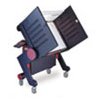Important Help America Vote Milestone Reached by State Board
ALBANY – 12/12/06- The New York State Board of Elections has received the results of an important study which will assist with the implementation of new voting systems throughout the State. Commissioned by the State Board to conduct the first-ever study of its kind in the United States, the American Institutes for Research (AIR) has submitted the NYS Voter System User Rate Assessment Study. New York has been a leader in the certification of voting systems throughout the United States and this study represents a major milestone accomplishment in the state’s extensive testing process.
 The report serves an important role by providing the State Board with vital information needed to help establish the minimum number of voting machines required in each polling place and the maximum number of voters that can vote on one voting system during the course of an ordinary 15-hour election day. The State Board will now have the responsibility to put the user rate assessment study into the context of an election in New York and establish for each new voting system the minimum number of voting machines required in each election district pursuant to State Election Law Section 7-203.
The report serves an important role by providing the State Board with vital information needed to help establish the minimum number of voting machines required in each polling place and the maximum number of voters that can vote on one voting system during the course of an ordinary 15-hour election day. The State Board will now have the responsibility to put the user rate assessment study into the context of an election in New York and establish for each new voting system the minimum number of voting machines required in each election district pursuant to State Election Law Section 7-203.
The machines used in the study were those which are currently undergoing certification testing for use in the State of New York, and included touch screen Direct Recording Electronic (DRE) voting systems manufactured by Avante, Liberty and Sequoia and Optical Scan voting systems manufactured by Diebold, Sequoia and ES&S. All DREs contained a voter verifiable paper audit trail (VVPAT) as required by state law and NYS Voting System Standards. The lever machines, currently in use, were also used in the voting study in order to ascertain a baseline number to compare results against.
This study was conducted in three different areas of New York State, to allow for diversity in study participants. Two days were spent at each of the test sites in Rochester, Albany and in Brooklyn. Among the sites used in the study were: a Center for the Disabled, a shopping mall, a board of elections, and a college campus. All sites were carefully chosen to ensure that they were both accessible to the disabled, and on a public transportation route. Interpreters were provided for participants at the test site in New York City, as certain areas of the City are required to translate ballots and other election materials into Spanish, Chinese and Korean.
AIR took care to target all demographic groups, and as a result, the study group was varied among age and ethnicity. Additional measures were taken to include voters with disabilities and voters who speak alternate languages.
Representatives of AIR will present the findings of the study at the December 14, 2006 meeting of the State Board of Elections. The meeting will begin at 12 Noon. A copy of the study can be found at www.elections.state.ny.us. The commissioners of the State Board of Elections will determine the minimum number of voting machines required in each polling place and the maximum number of voters that may be assigned to each type of voting machine at their meeting in mid-January.
Filed under: Action Alert!, Anti-War, Ballot issues, Books, election, elections, Electronic Voting, New York State Politics, Political Websites, Press Release, reform, US Politics, video Tagged: | UFPJ


 .
.




Leave a Reply